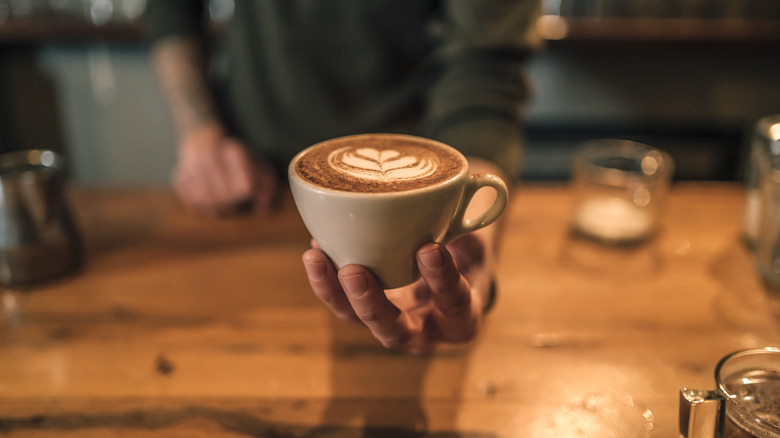How Much Caffeine Is There In Decaf Coffee?
A morning cup of coffee is a ritual for many Americans to get the day going and get out the door. But, not everyone drinks coffee for the caffeine boost.
There are many reasons people may opt for a cup of decaf coffee. Along with dry January, some might be doing a caffeine cleanse, they may want to avoid the jitters, or are just avoiding caffeine because of pregnancy or a heart condition. Or, maybe it's a late-night dessert treat and you want the taste of coffee but don't want to be up all night.
No matter the reason, it's important to know that decaf coffee isn't entirely free of caffeine. The decaffeination process, which attempts to remove caffeine from coffee beans, significantly reduces the content, but trace amounts still remain in the end. But, it is a lower caffeine alternative (like, a lot lower) than a regular cup of coffee.
What's the caffeine difference in decaf vs. regular coffee?
The amount of caffeine in decaffeinated coffee is not zero, but it is significantly lower compared to regular coffee. According to the National Coffee Association, decaffeination can remove about 97% or more of the caffeine in coffee beans. So, that means decaf beans only have about 3% caffeine. What does that mean for regular cups?
On average, an 8-ounce cup of decaf coffee contains about 2 to 15 milligrams of caffeine, according to the U.S. Food and Drug Administration (FDA). In contrast, a regular cup of coffee can pack anywhere from 95 to 165 milligrams of caffeine, depending on factors like the type of coffee bean and brewing method.
The FDA recommends no more than 400 milligrams of caffeine a day, which is about four to five cups of regular coffee. This of course comes with the caveat of individual tolerance to caffeine. Decaf is one way to enjoy the taste of coffee without having to worry about the side effects. But keep in mind that the exact caffeine content in decaf can vary based on the brand and the decaffeination process used.
How does decaffeination work?
According to the National Coffee Association, there are several ways coffee beans can be decaffeinated. One basic way is by soaking it. Green (unroasted) coffee beans are soaked in water to dissolve the soluble compounds, which include caffeine. Additionally, a solvent can be applied to the beans, which binds itself to the caffeine molecules. The solvent or water is then separated from the beans, carrying the dissolved caffeine with it. The beans are then dried to remove remaining moisture in them, and the caffeine can be recycled and sold to other companies.
The key is to get rid of the caffeine while still preserving the flavor compounds. Now, how much flavor is retained is up for debate. Decaf coffee can show a milder or less robust flavor than its caffeinated counterpart. But it shouldn't stop you from treating yourself to a decaf cold brew with a slice of cinnamon orange coffee cake. There's still plenty of flavor to work with, and a whole lot less caffeine.


